Positive Displacement (PD) Flow meters are volumetric flow measurement instruments that measure flow by passing a precise volume of fluid with each revolution. PD flow meters are precision instruments whose internal moving components are hydraulically locked in tandem with the volume of fluid moving through the flow meter.
The result is that the meter can measure intermittent flows, very low flow rates, and liquids of almost any viscosity. The PD meter instantly moves when there is fluid motion, and instantly stops when the fluid motion stops.
This type of measurement is not affected by the liquid’s viscosity, density or the turbulence in the pipe. All incompressible fluids will occupy the same volume and there is no need to correct the meter’s output to compensate for these factors.
Positive Displacement Flow Meters
Positive Displacement Meter is a type of flow meter that requires fluid to mechanically displace components in the meter in order for flow measurement. Positive displacement (PD) flow meters measure the volumetric flow rate of a moving fluid or gas by dividing the media into fixed, metered volumes (finite increments or volumes of the fluid).
A basic analogy would be holding a bucket below a tap, filling it to a set level, then quickly replacing it with another bucket and timing the rate at which the buckets are filled (or the total number of buckets for the “totalized” flow). With appropriate pressure and temperature compensation, the mass flow rate can be accurately determined.
These devices consist of a chamber(s) that obstructs the media flow and a rotating or reciprocating mechanism that allows the passage of fixed-volume amounts. The number of parcels that pass through the chamber determines the media volume.
The rate of revolution or reciprocation determines the flow rate. There are two basic types of positive displacement flow meters. Sensor-only systems or transducers are switch-like devices that provide electronic outputs for processors, controllers, or data acquisition systems.
Types of Positive Displacement Flow Meters
1. Reciprocating or oscillating piston
Each piston is mechanically or magnetically operated to fill a cylinder with the fluid and then discharge the fluid. Each stroke represents a finite measurement of the fluid.
2. Gear
Gear flow meters rely on internal gears rotating as fluid passes through them. There are various types of gear meters named mostly for the shape of the internal components
Oval Gear
Two rotating oval gears with synchronized teeth “squeeze” a finite amount of fluid through the meter for each revolution. With oval gear flow meters, two oval gears or rotors are mounted inside a cylinder.
As the fluid flows through the cylinder, the pressure of the fluid causes the rotors to rotate. As flow rate increases, so does the rotational speed of the rotors.
Helical Gear
Helical gear flow meters get their name from the shape of their gears or rotors. These rotors resemble the shape of a helix, which is a spiral-shaped structure.
As the fluid flows through the meter, it enters the compartments in the rotors, causing the rotors to rotate. Flow rate is calculated from the speed of rotation.
Nutating Disk
A disk mounted on a sphere is “wobbled” about an axis by the fluid flow and each rotation represents a finite amount of fluid transferred. A nutating disc flow meter has a round disc mounted on a spindle in a cylindrical chamber.
By tracking the movements of the spindle, the flow meter determines the number of times the chamber traps and empties fluid. This information is used to determine flow rate.
Rotary Vane
A rotating impeller containing two or more vanes divides the spaces between the vanes into discrete volumes and each rotation (or vane passing) is counted.
Diaphragm
Fluid is drawn into the inlet side of an oscillating diaphragm and then dispelled to the outlet. The diaphragm oscillating cycles are counted to determine the flow rate.
PD Meters Explained Briefly
PD flow meters are mainly named after the inbuilt mechanical device in the meter unit. Various types of positive displacement flow meters are available for industrial use. All these types are based on the common operating principle. Besides, they all are volumetric flow measuring devices.
Major types of positive displacement flow meters are mentioned below:
Reciprocating Piston Meters
These are also known as oscillating piston flow meters. These are one of the oldest positive displacement type flow meter designs. These types of meters are mainly of single or multiple-piston types.
Other types available are double acting pistons and rotary pistons. Selection of a particular type of piston meter depends on the range of flow rates necessary for an application.
Although piston meters are smaller in size and considered apt for handling only low flows of viscous liquids, yet they are proficient enough to deal with an extensive range of liquids. Major application areas of a reciprocating piston meter include viscous fluid services like oil metering on engine test stands, specifically where turndown ratio is not considered much crucial.
Also these meters can be employed on residential water service where they tend to pass partial quantities of dirt and fine sand along with water.
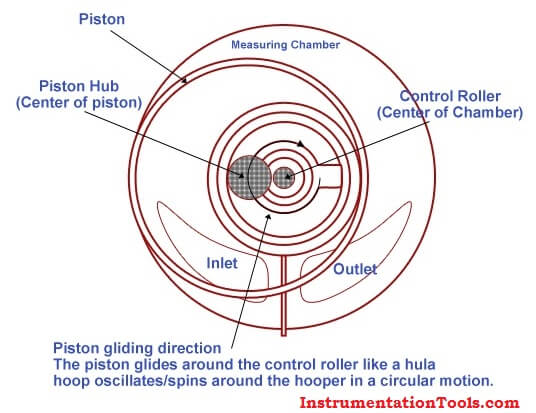
Oval-gear Meters
These types of meters consist of two rotating, oval-shaped gears constructed with synchronized, close fitting teeth. In an oval gear meter, the rotation of gear shafts causes a fixed amount of liquid to pass through the meter. By monitoring the number of shaft rotations, one can calculate liquid flow rate.
These types of meters prove to be very accurate when slippage between the housing and the gears is set very small. Turndown ratio of an oval gear meter gets influenced by the lubricating properties of the process fluid.
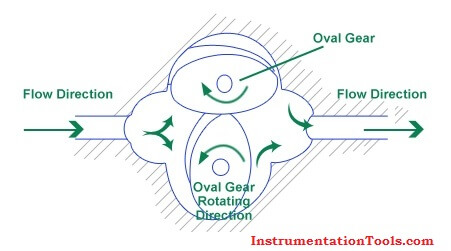
Nutating disk Meters
These are the widely used positive displacement type flow meters. They consist of a movable disk which is positioned on a concentric sphere situated inside a spherical side-walled unit. Universally, they are employed as residential water meters.
They exist in various sizes and capacities and can be constructed from a wide range of materials. Their typical size range varies from 5/8-in to 2-in sizes. They are ideal for pressure ranges around 150-psig with an upper limit of 300 psig.
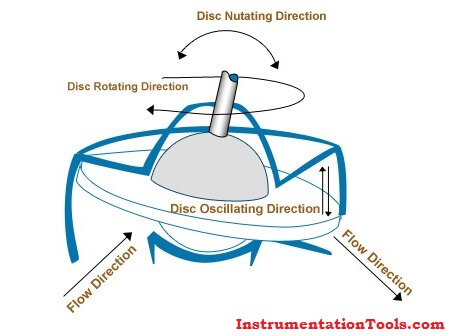
Rotary vane Meters
These types of meters exist in different designs. However, they all work on the same operating principle. These meters basically include uniformly divided rotating impellers with two or more compartments inside the chamber. The number of rotations of the impeller are counted and recorded in volumetric units. These types of meters are frequently employed in the petroleum industry.
Based upon the construction material, maximum pressure and maximum temperature limits of rotary vane meters are 350°F and 1,000 psig respectively. Their Viscosity limit ranges between 1 and 25,000 centipoise.
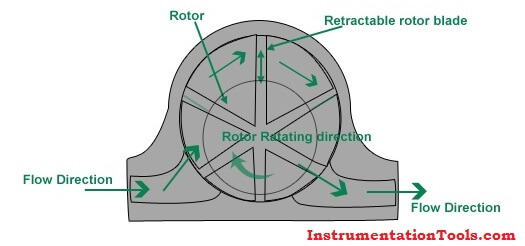
Helix Meters
These types of meters are made up of two radically pitched helical rotors which results in an axial liquid displacement from one side of the chamber to the other side.
Both the rotors are geared together and there is a very small clearance between the rotors and the casing.
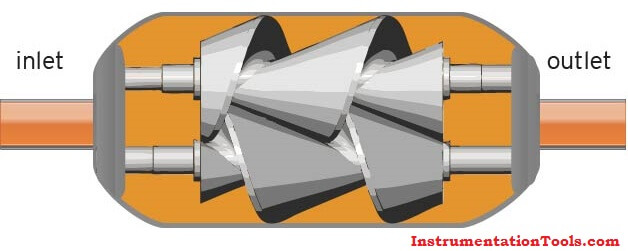
Roots Flow Meters
The roots flow meter is similar in many respects to the oval gear flow meter. A design is shown where two-lobed impellers rotate in opposite directions to each other within the body housing. These peanut-shaped gears sweep out an exact volume of liquid passing through the flow measurement chamber during each rotation.
The flow measurement can be calculated by measuring the rotation speed. In contrast to nutating disc meters, the calibration factor does not vary with viscosity.
Multi-Piston Flow Meters
Piston Flow meters of either single or multiple designs find widespread use in fuel flow meter dispensing and the low flow measurement of light hydrocarbons. In the multiple piston design shown below, the pistons are arranged in opposing pairs and connected through a series of cranks to the register mechanism.
This arrangement ensures that when one cylinder is ported to the inlet, the opposing cylinder is ported to the outlet so that fluid has to flow through the flow measuring chambers with minimum leakage. This design introduces significant pulsations into the flow, which are generally not suitable for flow rates above 100 l/min.
Bi-Rotor Flow Meters
Bi-rotor flow meter features two precisely machined rotating members known as helical rotors which rotate and mesh within the meter’s interior housing in order to form a flow measuring chamber of known volume which may be used to accurately determine flow measurement as a function of the rotors’ velocity.
The helical rotors’ motion is transmitted to the flow transmitter display via a sealed coupling and drive system that enables the flow transmitter display to provide accurate data for both flow rate and total accumulated flow.
The unique helical rotor design provides a number of advantages over traditional gear-type positive displacement flow meter including reduced pressure drop, the virtual elimination of down-stream pulsations, enhanced particle tolerance, and reduced maintenance.
The advantages provided by the helical rotor make the Positive Displacement flow meter an ideal choice for many applications including fuel flow meter, oil-in-water media and fluids with entrained solids providing strainer or filters are used before fluids enters the flow meter.
Advantages and considerations
Positive displacement flow meters are very accurate and have high turndown. They can be used in very viscous, dirty and corrosive fluids and essentially require no straight runs of pipe for fluid flow stream conditioning though pressure drop can be an issue. They are widely used in the custody transfer of oils and liquid fluids (gasoline) and are applied on residential home natural gas and water metering.
A diaphragm meter, with which most homes are equipped, is an example of a positive displacement meter. This type of meter is appealing in certain custody transfer flow applications where it is critical that the metering be functional in order for any flow to take place.
PD flow meters, with internal wiping seals, produce the highest differential pressure (and subsequently greatest pressure drop head loss) of all the flow meter types. Meters that rely on a liquid seal create a relatively low-pressure drop.
Positive displacement (PD) meters can measure both liquids and gases. Like turbine meters, PD flow meters work best with clean, non-corrosive, and non-erosive liquids and gases, although some models will tolerate some impurities.
Because of their high accuracy, PD meters are widely used at residences to measure the amount of gas or water used. Other applications include chemical injection, fuel measurement, precision test stands, high pressure, hydraulic testing, and similar precision applications.
Some designs require that only lubricating fluid be measured, because the rotors are exposed to the fluid. PD meters differ from turbine meters in that they handle medium and high-viscosity liquids well. For this reason, they are often used to measure the flow of hydraulic fluids.
Compared with orifice-type meters, PD meters require very little straight upstream piping since they are not sensitive to uneven flow distribution across the area of the pipe. Positive displacement flow meters can provide better relative accuracy at low flows than orifice-type flow meters.
However, a positive displacement meter can be considerably heavier and more costly than non-positive-displacement types such as orifice plates, magnetic or vortex flow meters.
If you liked this article, then please subscribe to our YouTube Channel for Instrumentation, Electrical, PLC, and SCADA video tutorials.
You can also follow us on Facebook and Twitter to receive daily updates.
Read Next:
- Swirl Flow Meters Principle
- Flow Meters Troubleshooting
- What is Coriolis Flow Meter ?
- Open Channel Flow Principle
- Ultrasonic Flow Sensor Animation
Rotary (Oscillating) Piston and nutating disc meters are displacement meters, if we use the terminology at the end of the 19th century, but they are only semi-positive, not true positive displacement meters because open flow paths exist at portions of the measurement cycle.
They are not reciprocating piston meters though the multi piston meters are. But Multi can mean one piston (the Thomas Kennedy original design in 1824) or two pistons 3 piston 4 or even (Beck Meters) 5 pistons. These are true PD meters renowned for their accuracy and linearity.
Rotary piston and nutating disc are the geometric limit forms of the generic conic meter technology. A number of other variants were patented, mainly by Lewis Nash and at least one other was manufactured for a period by Leeds Meter Company. All conic meters are semi-positive.